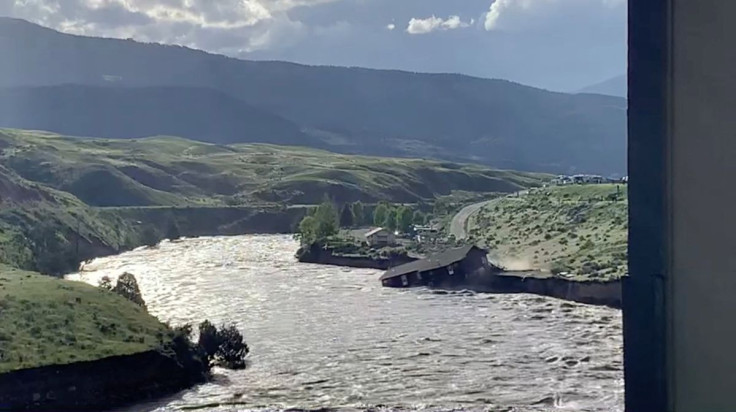Officials Warn Residents Of ‘Unsafe’ Drinking Water, Wildlife Spotting After Historic Yellowstone Flooding
KEY POINTS
- Bears and deer were spotted in Park County after the Yellowstone River reached 10.9 feet
- Gardiner officials have warned against drinking water in the area
- All entrances to Yellowstone National Park have been closed
Officials are assessing damage after the historic flooding at Yellowstone earlier this week that forced the closure of Yellowstone National Park. Authorities have warned of “unsafe” drinking water in surrounding areas as well as the potential passing of displaced wildlife in some properties.
In a Facebook post, officials of Park County in Montana said extensive flooding throughout the county resulted in drinking water becoming “unsafe in many areas.” While the river near Livingston and Paradise Valley has since receded, scattered showers could still cause “a resurgence of water flow,” they said. Furthermore, several bears and deer have been spotted in some areas. “Residents should be advised that displaced wildlife may be passing through properties,” the authorities added.
Gardiner, Cooke City and Silver Gate still isolated and surrounded by water. Do not drink order for Gardiner water with concerns over well water in Cooke City and Silver Gate. Essential-only travel encouraged on Hwy 89 S of mm 52.5. Trail Creek Road for emergency travel only. pic.twitter.com/uTiRDAxyDQ
— Maritsa Georgiou (@MaritsaGeorgiou) June 14, 2022
It is worth noting that part of Yellowstone National Park is located in the southern part of Park County.
Officials at Gardiner have issued a “do not consume Gardiner drinking water” order since Monday afternoon due to submerged wells and a broken water main. The order has not yet been lifted as of writing. Residents and visitors going to the Livingston Hospital have been advised to go to Bozeman for hospital emergencies or check-ins. Livingston Hospital is closed until further notice.
Evacuating visitors and residents have been advised to use Highway 89 S. and East River Road, which is located north of Gardiner. For evacuees, a 35 mph speed limit has been set.
⚠️UPDATE (6/14 @ 6:38pm)⚠️
— Yellowstone National Park (@YellowstoneNPS) June 15, 2022
Northern portion of Yellowstone likely to remain closed for substantial length of time due to severely damaged, impacted infrastructure. Visitors traveling to park soon must stay informed about current situation, roads & weather https://t.co/mymnqGvcVB pic.twitter.com/li6Vwy4qLt
In its latest update, the National Park Service noted that all entrances to the Yellowstone National Park “remain temporarily CLOSED” as a precautionary measure “to prevent visitors from being stranded in the park if conditions worsen.” The park closed all five entrances Monday for the first time in 34 years.
The Yellowstone River reached 10.9 feet Monday, exceeding its own record of 10.7 feet in 1997, according to the National Weather Services (NWS) in Billings, CNN reported. The NWS previously said snowmelt moving toward streams and rivers as well as increased rain around Yellowstone National Park added to the floodwaters.
Wild video shows a building collapsing into the rapidly moving flood waters of the Yellowstone River in Gardiner, Montana. https://t.co/DCtsN3syCB pic.twitter.com/0mfmwXjUeK
— WTAE-TV Pittsburgh (@WTAE) June 14, 2022
Current conditions of Yellowstone’s North Entrance Road through the Gardner Canyon between Gardiner, Montana, and Mammoth Hot Springs.
— Yellowstone National Park (@YellowstoneNPS) June 13, 2022
We will continue to communicate about this hazardous situation as more information is available. More info: https://t.co/mymnqGvcVB pic.twitter.com/S5ysi4wf8a
On Tuesday, a video showed the moment an entire building fell into the Yellowstone River after the deck gave in to strong currents. Another video with nearly 2 million views showed large parts of roads on the park’s North Entrance crumbling into the water.
As of Tuesday, more than 10,000 visitors have been ordered to leave Yellowstone, the Associated Press reported. Roads to the park are expected to remain closed for up to a week, park superintendent Cam Sholly said. Northern entrances in particular may be closed throughout summer, she added.
News Release: March 1, 2022, marks the 150th anniversary of the establishment of Yellowstone National Park. Beginning March 1, the park will host and participate in a wide range of activities to commemorate 150 years of Yellowstone. Learn more: https://t.co/Tb77dbkCVV pic.twitter.com/9He96tcMrM
— Yellowstone National Park (@YellowstoneNPS) February 28, 2022
The Yellowstone National Park celebrated 150 years in March. The multi-million-acre park is home to 25 landmarks, sites and districts included on the National Register of Historic Places.

© Copyright IBTimes 2024. All rights reserved.






















